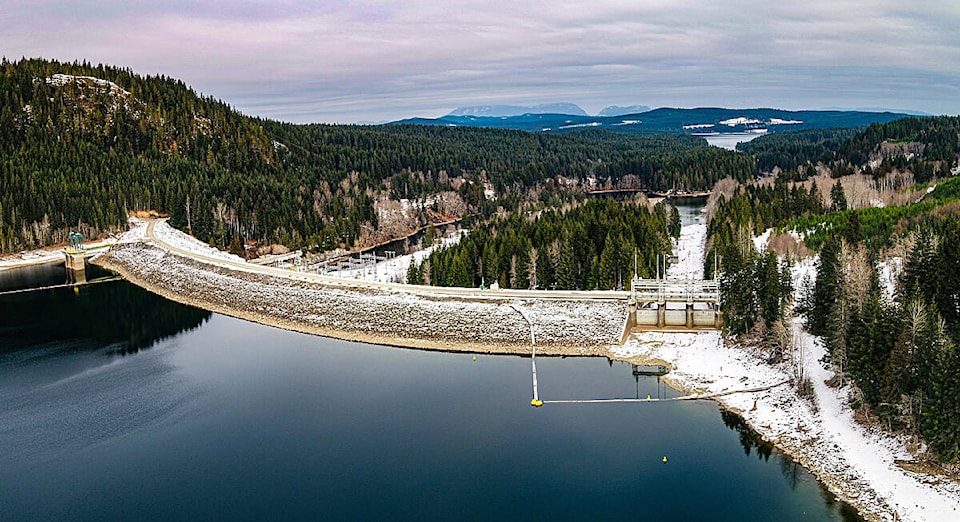By Stephen Watson,
BC Hydro
This past fall was the driest fall season on record for the Campbell River system. Then the tap abruptly turned on in full force for one of the wettest starts to the winter season.
With big weather fluctuations and ongoing climate change we often get questions about how or what BC Hydro is doing to prepare. We’ve been thinking and acting on it for years. I would like to cover off some of those actions related to our Campbell River hydroelectric operations and water storage. This includes modelling, capital projects, in the moment versatility and the benefits of an integrated power system.
For modelling, our records go back about 60 years and we have daily traces for each of those years on how much water entered the watershed. Every year we learn about another weather scenario of very dry or very wet. In all of our years of record for the fall season, there has always been a shift to wet weather by around the end of October. We didn’t get any large rain events over the fall season for this watershed until it finally turned wet on Dec. 24. That’s unprecedented.
We are always looking at the near-term and long-term weather forecasts, current snowpack conditions, hydrologic forecasts, and are conservative in our decisions for environmental and social considerations while generating clean power. Upon reflection, we managed through this past fall as well as possible. Salmon were able to spawn and we tried to keep those salmon eggs covered with water.
Since 2007, we’ve been partnering with the Pacific Climate Impacts Consortium and others on modelling climate change projections of what the future may look like for rain, snowpack and dry weather across B.C. The results from those ongoing models for our Campbell River watershed show a trend towards wetter and milder conditions in the fall and winter, and drier spring and summers. The annual precipitation looks to be the same, just dispersed differently.
For our capital projects, we are preparing to undertake major upgrades to the Strathcona, Ladore and John Hart dams. These projects rightly get a lot of attention for maintaining downstream public safety. While the projects are mainly focused on seismic upgrades, a significant component will be improvements to the water discharge reliability and water management flexibility of these dams that were built in the 1940s and 1950s.
For reliability, all the spillway gates at the three dams are planned to be replaced, including new hoist systems and back-up power supply. No matter how dry or wet the conditions may be, they will be dependable – even after a major earthquake.
For flexibility, the best example is the Strathcona Dam Water Discharge Upgrade Project where we are planning to build a channel in rock that will curve around the right bank of the dam with a low-level outlet gate used to control water discharge.
While the channel is mainly designed to allow for reservoir water level lowering after a seismic event, there is another benefit in years of very low water like this past fall. The Upper Campbell Reservoir/Buttle Lake water level moved well below the sill of the existing spillway gates. When that happens the only way to pass water downstream is through the powerhouse.
This past fall we had one of those two generators go off-line. It made providing downstream flows tenuous. With the proposed channel, we will have security in being able to provide downstream water flows no matter what the reservoir level is or how the powerhouse is performing. You can learn more about the project at majorprojects.ca.
For in-the-moment versatility, sometimes the best planning and capital improvements may not be able to accommodate a certain weather event. This year at the Upper Quinsam Lake, the record dry weather led to very low water storage conditions and the risk of running out of water. We quickly responded, voluntarily, to temporarily install pumps to help supplement water flows to benefit downstream fish habitat. This quick action is an example of being agile to very challenging weather situations.
For our integrated power system, while we did have low water conditions and power generation this fall in Campbell River, we are connected to the wider BC Hydro system and could supply our customers with electricity from off Vancouver Island.
Since late December, the wet weather has recovered the water storage within the system and we are now at normal water storage levels and river flows. We will be ready for whatever nature provides us in 2023, and continue to prepare and plan for our hydroelectric facilities to meet future weather events.
Stephen Watson is a Stakeholder Engagement Advisor for BC Hydro.
